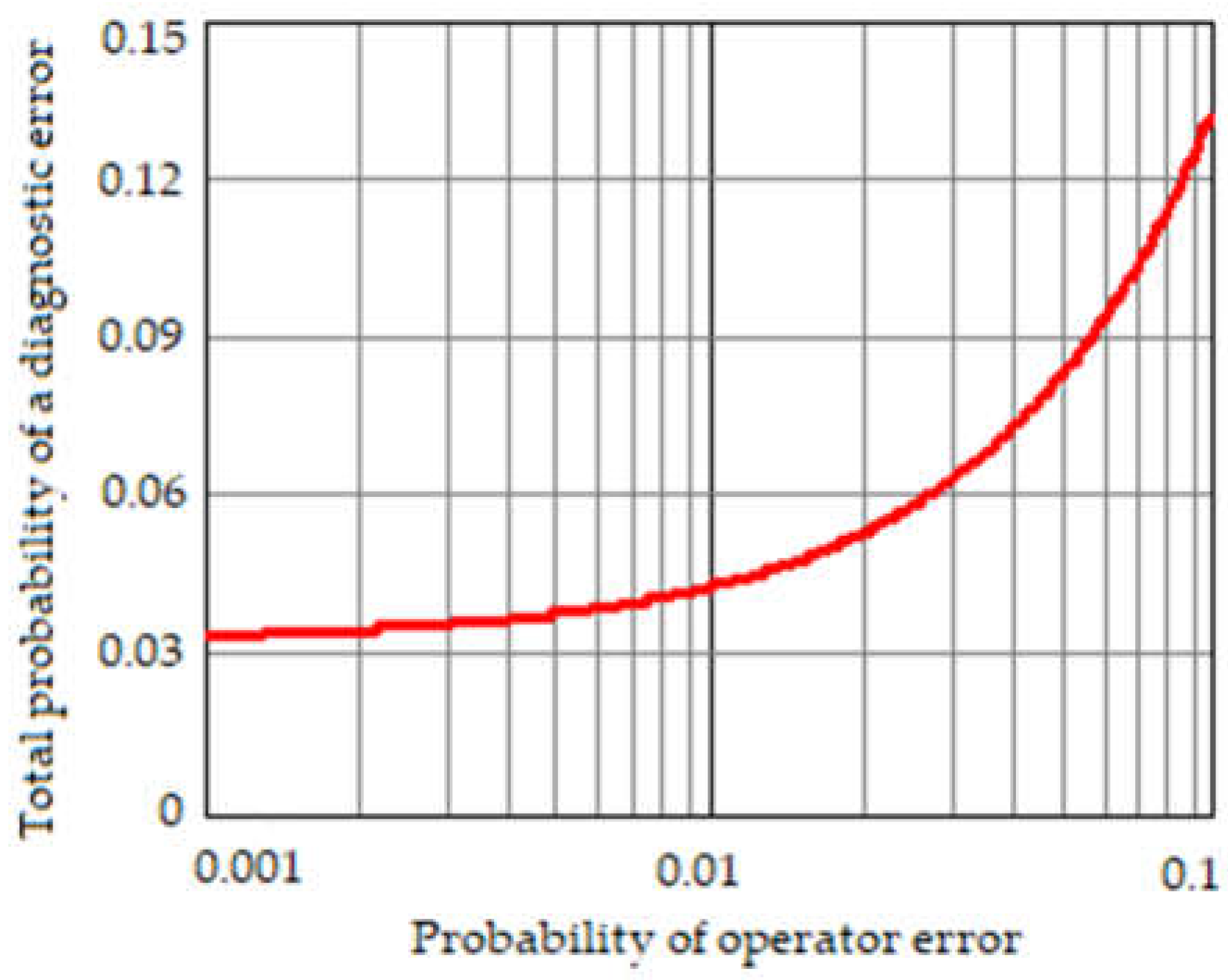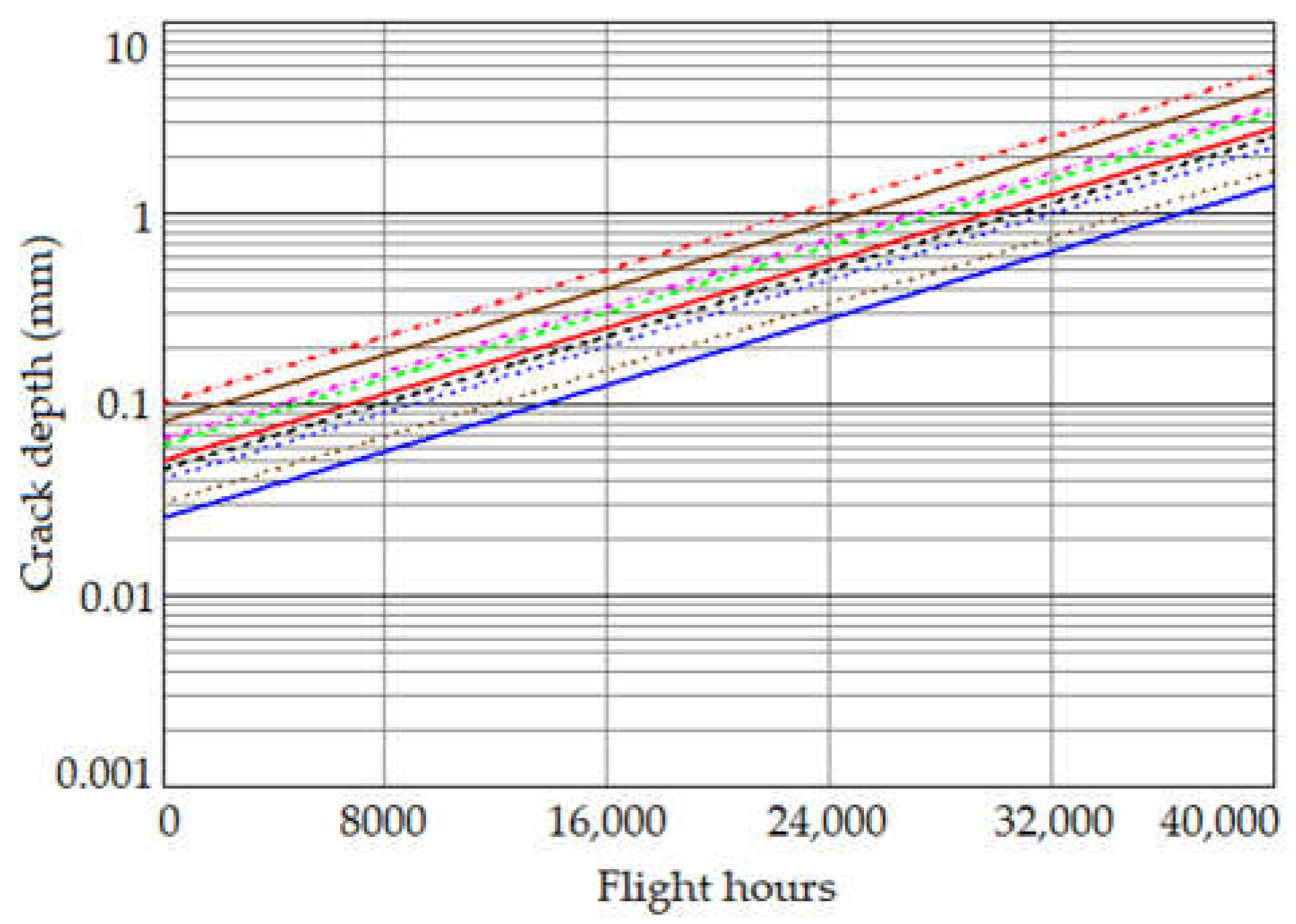Uncertainty Quantification of Imperfect Diagnostics
Abstract
:1. Introduction
- (1).
- The SoTD includes OD, DT, and HO. However, the known indicators of diagnostic trustworthiness consider at best only the characteristics of OD and DT. Until now, there have been no published studies that would simultaneously consider the main characteristics of all SoTD components.
- (2).
- In principle, the assessment of trustworthiness can be carried out using the same statistical methods as in binary classification problems. However, statistical methods necessitate the collection of large amounts of data for evaluating trustworthiness indicators. Furthermore, this will have to be carried out whenever testing algorithms are changed or improved. Analytical models are significantly simpler and less expensive to use.
- (3).
- The use of the well-known F1 score measure is also impractical to employ for assessing diagnostic trustworthiness for the following reasons. Firstly, it prioritizes precision and recall equally, but in practice, different sorts of classification errors result in various losses, and secondly, the F1 score is calculated using merely a statistical method.
2. Literature Review
3. Quantifying Diagnostic Uncertainty
4. Results and Discussion
4.1. Case Study 1
4.2. Case Study 2
5. Conclusions
Author Contributions
Funding
Institutional Review Board Statement
Informed Consent Statement
Data Availability Statement
Conflicts of Interest
Abbreviations
| CF | Cumulative function |
| DP | Diagnostic parameter |
| DT | Diagnostic tool |
| HO | Human operator |
| OD | Object of diagnostics |
| Probability density function | |
| PTN | Probability of true negative |
| PTP | Probability of true positive |
| RF | Reliability function |
| SoTD | System of technical diagnostics |
| VHF | Very high frequency |
References
- Okoro, O.C.; Zaliskyi, M.; Dmytriiev, S.; Solomentsev, O.; Sribna, O. Optimization of maintenance task interval of aircraft systems. Int. J. Comput. Netw. Inf. Secur. 2022, 2, 77–89. [Google Scholar] [CrossRef]
- Raza, A.; Ulansky, V. Through-life maintenance cost of digital avionics. Appl. Sci. 2021, 11, 715. [Google Scholar] [CrossRef]
- Raza, A. Maintenance model of digital avionics. Aerospace 2018, 5, 38. [Google Scholar] [CrossRef] [Green Version]
- Rocha, R.; Lima, F. Human errors in emergency situations: Cognitive analysis of the behavior of the pilots in the Air France 447 flight disaster. Gestão Produção 2018, 25, 568–582. [Google Scholar] [CrossRef] [Green Version]
- Borodachev, I.A. The Main Issues of the Theory of Production Accuracy; USSR Academy of Sciences Publishing House: Moscow, USSR, 1959; 417p. [Google Scholar]
- Mikhailov, A.V. Operational Tolerances and Reliability in Radio-Electronic Equipment; Sov. Radio: Moscow, USSR, 1970; 216p. [Google Scholar]
- Belokon, R.N.; Kendel, V.G.; Poltoratskaya, V.K. Study of the Influence of the Correlation between Checked Parameters on the Characteristics of the Instrumental Checking Trustworthiness. In Proceedings of the Applied Mathematics: Proceedings of the City Seminar on Applied Mathematics, Irkutsk, USSR, 3–5 May 1971; Volume 3, pp. 17–21. [Google Scholar]
- Evlanov, L.G. Health Monitoring of Dynamic Systems; Nauka: Moscow, USSR, 1979; 432p. [Google Scholar]
- Ponomarev, N.N.; Frumkin, I.S.; Gusinsky, I.S. Automatic Health Monitoring Instruments for Radio-Electronic Equipment: Design Issues; Sov. Radio: Moscow, USSR, 1975; 328p. [Google Scholar]
- Kudritsky, V.D.; Sinitsa, M.A.; Chinaev, P.I. Automation of Health Monitoring of Radio Electronic Equipment; Sov. Radio: Moscow, USSR, 1977; 255p. [Google Scholar]
- Goremykin, V.K.; Ulansky, V.V. Effectiveness Indicators of Technical Diagnostic Systems. In Problems of Increasing the Efficiency of Aviation Equipment Operation; Interuniversity Collection of Scientific Papers; Kyiv Institute of Civil Aviation Engineers: Kyiv, Ukrainian SSR, 1978; Volume 2, pp. 159–167. [Google Scholar]
- Ignatov, V.A.; Ulansky, V.V.; Goremykin, V.K. Effectiveness of Diagnostic Systems. In Evaluation of the Quality Characteristics of Complex Systems and System Analysis; Collection of Scientific Papers; Academy of Science of USSR: Moscow, USSR, 1978; pp. 134–141. [Google Scholar]
- Ulansky, V.; Machalin, I.; Terentyeva, I. Assessment of health monitoring trustworthiness of avionics systems. Int. J. Progn. Health Manag. 2021, 12, 1–14. [Google Scholar] [CrossRef]
- Ho, C.Y.; Lai, Y.C.; Chen, I.W.; Wang, F.Y.; Tai, W.H. Statistical analysis of false positives and false negatives from real traffic with intrusion detection/prevention systems. IEEE Commun. Mag. 2012, 50, 146–154. [Google Scholar] [CrossRef]
- Breitgand, D.; Goldstein, M.; Henis, E.; Shehory, O. Efficient control of false negative and false positive errors with separate adaptive thresholds. IEEE Trans. Netw. Serv. Manag. 2011, 8, 128–140. [Google Scholar] [CrossRef]
- Foss, A.; Zaiane, O.R. Estimating True and False Positive Rates in Higher Dimensional Problems and Its Data Mining Applications. In Proceedings of the 2008 IEEE International Conference on Data Mining Workshops, Pisa, Italy, 15–19 December 2008. [Google Scholar] [CrossRef] [Green Version]
- Mane, S.; Srivastava, J.; Hwang, S.Y.; Vayghan, J. Estimation of False Negatives in Classification. In Proceedings of the Fourth IEEE International Conference on Data Mining (ICDM’04), Brighton, UK, 1–4 November 2004. [Google Scholar] [CrossRef]
- Scott, C. Performance measures for Neyman–Pearson classification. IEEE Trans. Inf. Theory 2007, 53, 2852–2863. [Google Scholar] [CrossRef]
- Ebrahimi, N. Simultaneous control of false positives and false negatives in multiple hypotheses testing. J. Multivar. Anal. 2008, 99, 437–450. [Google Scholar] [CrossRef] [Green Version]
- Pounds, S.; Morris, S.W. Estimating the occurrence of false positives and false negatives in microarray studies by approximating and partitioning the empirical distribution of p-values. Bioinformatics 2003, 19, 1236–1242. [Google Scholar] [CrossRef] [Green Version]
- Hand, D.; Christen, P. A note on using the F-measure for evaluating record linkage algorithms. Stat. Comput. 2018, 28, 539–547. [Google Scholar] [CrossRef] [Green Version]
- Sokolova, M.; Lapalme, G. A systematic analysis of performance measures for classification tasks. Inf. Process. Manag. 2009, 45, 427–437. [Google Scholar] [CrossRef]
- Tharwat, A. Classification assessment methods. Appl. Comput. Inform. 2021, 17, 168–192. [Google Scholar] [CrossRef]
- Hand, D.J.; Christen, P.; Kirielle, N. F*: An interpretable transformation of the F-measure. Mach. Learn. 2021, 110, 451–456. [Google Scholar] [CrossRef] [PubMed]
- Zhou, T.; Zhang, L.; Han, T.; Droguett, E.L.; Mosleh, A.; Chan, F.T.S. An uncertainty-informed framework for trustworthy fault diagnosis in safety-critical applications. Reliab. Eng. Syst. Saf. 2023, 229, 108865. [Google Scholar] [CrossRef]
- Takahashi, K.; Yamamoto, K.; Kuchib, A.; Koyama, T. Confidence interval for micro-averaged F1 and macro-averaged F1 scores. Appl. Intell. 2022, 52, 4961–4972. [Google Scholar] [CrossRef] [PubMed]
- Ulansky, V. A Method for Evaluating the Effectiveness of Diagnosing Complex Technical Systems. Ph.D. Thesis, National Aviation University, Kyiv, Ukrainian SSR, 1981. [Google Scholar]
- Havlikovaa, M.; Jirglb, M.; Bradac, Z. Human reliability in man-machine systems. Procedia Eng. 2015, 100, 1207–1214. [Google Scholar] [CrossRef] [Green Version]
- Smith, D. Reliability, Maintainability and Risk; Butterworth-Heinemann: Oxford, UK, 2011; pp. 144–146. [Google Scholar]
- Jun, L.; Huibin, X. Reliability analysis of aircraft equipment based on FMECA method. Phys. Procedia 2012, 25, 1816–1822. [Google Scholar] [CrossRef] [Green Version]
- Molent, L.; Barter, S.A. The lead fatigue crack concept for aircraft structural integrity. Procedia Eng. 2010, 2, 363–377. [Google Scholar] [CrossRef] [Green Version]
- Molent, L.; Barter, S.A. A comparison of crack growth behaviour in several full-scale airframe fatigue tests. Int. J. Fatigue 2007, 29, 1090–1099. [Google Scholar] [CrossRef]
- Jones, R.; Molent, L.; Pitt, S. Understanding crack growth in fuselage lap joints. Theor. Appl. Fract. Mech. 2008, 49, 38–50. [Google Scholar] [CrossRef]
- Huynh, J.; Molent, L.; Barter, S. Experimentally derived crack growth models for different stress concentration factors. Int. J. Fatigue 2008, 30, 1766–1786. [Google Scholar] [CrossRef]
- Walpole, R.; Myers, R.; Myers, S.; Ye, K. Probability and Statistics for Engineers and Scientists, 9th ed.; Pearson Prentice Hall: Boston, MA, USA, 2012; pp. 211–217. [Google Scholar]
- Felice, M.V.; Velichko, A.; Wilcox, P.D. Accurate depth measurement of small surface-breaking cracks using an ultrasonic array post-processing technique. NDT E Int. 2014, 68, 105–112. [Google Scholar] [CrossRef] [Green Version]
- Chen, X.; Ye, Z.; Xia, J.Y.; Wang, J.X.; Ji, B.H. Double-probe ultrasonic detection method for cracks in steel structure. Appl. Sci. 2020, 10, 8436. [Google Scholar] [CrossRef]





| Object of Diagnostics | Diagnostic Parameter | Nominal Value | Lower and Upper Tolerance Limits | Standard Deviation | ||
|---|---|---|---|---|---|---|
| No. | Name | Nν | aν and bν | Diagnostic Parameter, σν | Measurement Error, σt,ν | |
| VHF communication system | 1 | Transmitter power, W | 20 | 16 | 1.79 | 0.55 |
| 2 | Receiver sensitivity, μV | 2.5 | 3 | 0.23 | 0.05 | |
| 3 | Modulation index, % | 92.5 | 85–100 | 3.48 | 0.35 | |
| Name of Communication System’s State | Technical Condition of the Communication System | A Priori Probability of the System State P(Si) |
|---|---|---|
| S1 | 111 | 0.942 |
| S2 | 110 | |
| S3 | 101 | |
| S4 | 011 | |
| S5 | 100 | |
| S6 | 010 | |
| S7 | 001 | |
| S8 | 000 |
| Number of the DP No. | A Priori Probability That the ν DP Is within the Tolerance Range | A Priori Probability That the OD Is Operable P | Probability of a False Negative for the ν DP | Probability of a False Positive for the ν DP |
|---|---|---|---|---|
| 1 | 0.987 | 0.942 | 0.006335 | 0.002719 |
| 2 | 0.985 | 0.004430 | 0.002463 | |
| 3 | 0.969 | 0.003605 | 0.002749 |
| The Values of Reliability Characteristics of HO and DT | The Probabilities of Correct and Incorrect Decisions | |||||
|---|---|---|---|---|---|---|
| P(H1) = 0.98, P(H2) = 0.011, P(H3) = 0.009, P(D1) = 0.97, P(D2) = 0.01, P(D3) = 0.02 | 0.902 | 0.949 | ||||
| P(H1) = 1, P(H2) = P(H3) = 0, P(D1) = 1, P(D2) = P(D3) = 0, | 0.928 | 0.9779 | ||||
Disclaimer/Publisher’s Note: The statements, opinions and data contained in all publications are solely those of the individual author(s) and contributor(s) and not of MDPI and/or the editor(s). MDPI and/or the editor(s) disclaim responsibility for any injury to people or property resulting from any ideas, methods, instructions or products referred to in the content. |
© 2023 by the authors. Licensee MDPI, Basel, Switzerland. This article is an open access article distributed under the terms and conditions of the Creative Commons Attribution (CC BY) license (https://creativecommons.org/licenses/by/4.0/).
Share and Cite
Ulansky, V.; Raza, A. Uncertainty Quantification of Imperfect Diagnostics. Aerospace 2023, 10, 233. https://doi.org/10.3390/aerospace10030233
Ulansky V, Raza A. Uncertainty Quantification of Imperfect Diagnostics. Aerospace. 2023; 10(3):233. https://doi.org/10.3390/aerospace10030233
Chicago/Turabian StyleUlansky, Vladimir, and Ahmed Raza. 2023. "Uncertainty Quantification of Imperfect Diagnostics" Aerospace 10, no. 3: 233. https://doi.org/10.3390/aerospace10030233







